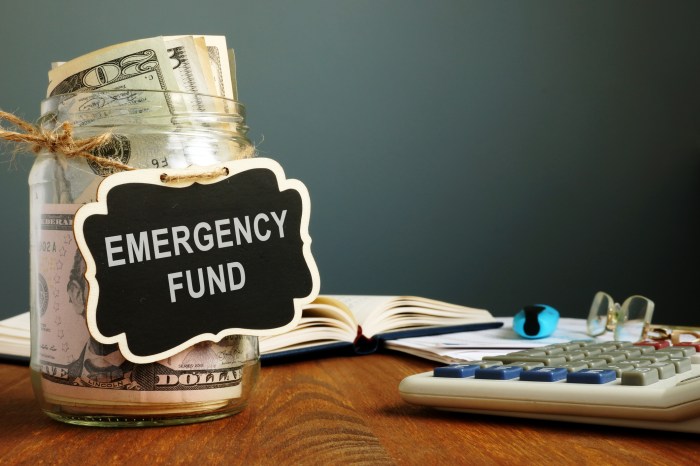Yo, check it – when it comes to Saving for emergencies, you gotta be ready for anything that life throws your way. This ain’t your typical boring finance talk, we’re diving into why it’s crucial to stash some cash for those unexpected curveballs. Get ready for some real talk on financial safety nets and how they can give you peace of mind like nothing else.
Now, let’s break it down and lay out the deets on why emergency savings are a game-changer.
Importance of Saving for Emergencies
Saving for emergencies is crucial because unexpected expenses can arise at any time, and having a financial safety net can provide peace of mind and security. Instead of relying on credit cards or loans during a crisis, having emergency savings allows you to cover expenses without going into debt.
Examples of Unexpected Expenses
- Medical emergencies that require immediate attention and costly treatments.
- Car repairs or breakdowns that are essential for daily transportation.
- Home repairs due to unexpected damages or maintenance issues.
Setting Emergency Savings Goals
In order to effectively save for emergencies, it is important to set clear goals to work towards. This involves determining the right amount to save, allocating a percentage of your income towards savings, creating a realistic timeline, and adjusting your goals as needed based on changes in your financial situation.
Determining the Right Amount to Save
To determine the right amount to save for emergencies, financial experts often recommend saving three to six months’ worth of living expenses. This can help cover unexpected costs such as medical emergencies, car repairs, or job loss without having to rely on credit cards or loans.
Ideal Percentage of Income to Allocate Towards Emergency Savings
Financial advisors suggest allocating at least 10-20% of your monthly income towards emergency savings. This ensures that you are consistently building up your savings cushion to handle any unforeseen expenses that may arise.
Creating a Realistic Timeline
To create a realistic timeline to reach your emergency savings goals, start by calculating how much you need to save based on your monthly expenses. Then, divide this total amount by the monthly savings goal you’ve set for yourself. This will give you a clear timeline of how long it will take to reach your savings target.
Adjusting Savings Goals Based on Changes
It’s important to regularly review and adjust your emergency savings goals based on any changes in your income or expenses. If you receive a raise at work or pay off a debt, consider increasing your monthly savings contributions. On the other hand, if you face unexpected expenses that deplete your savings, adjust your goals accordingly to ensure you stay on track towards financial security.
Building an Emergency Fund
Building an emergency fund is crucial for financial security and peace of mind. It serves as a safety net during unexpected situations like medical emergencies, job loss, or car repairs.
Different Methods for Building an Emergency Fund
There are various methods to build your emergency fund:
- Set up automatic transfers from your checking account to a separate savings account dedicated to emergencies. This ensures consistent contributions without the need for manual transfers.
- Utilize windfalls such as tax refunds, work bonuses, or cash gifts to boost your emergency fund quickly.
Budgeting Techniques to Prioritize Emergency Savings
Prioritizing emergency savings in your budget is essential:
- Create a budget that allocates a specific percentage of your income towards emergency savings before other expenses.
- Track your spending habits and identify areas where you can cut back to increase your contributions to the emergency fund.
Importance of Keeping Emergency Savings Separate
It’s crucial to keep your emergency savings separate from regular savings to avoid dipping into it for non-emergency expenses:
- Having a separate account makes it easier to track the growth of your emergency fund and prevents the temptation to use it for non-emergencies.
- Mentally separating the funds helps you prioritize and protect your emergency savings for when you truly need it.
Where to Store Emergency Funds for Easy Access
Consider storing your emergency funds in easily accessible accounts:
- High-yield savings accounts offer competitive interest rates while providing quick access to funds when emergencies arise.
- Money market accounts are another option that combines the benefits of a savings account with the flexibility of a checking account for easy access.
Utilizing Emergency Savings

In times of financial distress or unexpected emergencies, it is crucial to know when and how to utilize your emergency savings. These funds are specifically set aside to provide a safety net during challenging situations, offering peace of mind and financial stability.
When to Use Emergency Savings
- Medical emergencies: Unexpected medical bills or emergencies that are not fully covered by insurance.
- Car repairs: Sudden breakdowns or accidents that require immediate repairs.
- Job loss: In the event of sudden unemployment or loss of income.
Importance of Replenishing Emergency Savings
It is essential to replenish your emergency savings after using them to ensure you are prepared for future unexpected expenses.
- Set a goal to replenish the funds as soon as possible to maintain financial security.
- Adjust your budget to allocate a portion of your income towards rebuilding your emergency fund.
Tips to Avoid Temptation
- Separate your emergency savings from your regular checking account to reduce the temptation to use it for non-urgent expenses.
- Create a budget and stick to it to avoid unnecessary spending that may deplete your emergency fund.
- Consider setting up automatic transfers to your emergency savings account to ensure consistent contributions.
